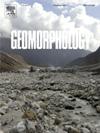The use of fractal geometry for classifying polygonal surface structures and their implications on environmental conditions – A new proxy for planetary sciences?
IF 3.1
2区 地球科学
Q2 GEOGRAPHY, PHYSICAL
引用次数: 0
Abstract
Patterned ground, especially polygonal surface structures, are of particular importance for planetary sciences, as they are known from the Earth as well as from other celestial bodies such as Mars, Mercury, Venus and Pluto. They are therefore ideally suited as a basis for analogue studies. However, the classification of these structures is often based on individually and intuitively perceived parameters, which are difficult to determine, especially with remote sensing data.
In our work, we therefore propose a new classification of polygonal surface structures. Based on a variety of conventional and established geometric parameters, in combination with the innovative approach of fractal geometry, we suggest a classification based on objective mathematical parameters. Based on remote sensing data from more than 100 sites, we show that polygons of different depositional environments can be distinguished and assigned to specific environmental conditions based on purely geometric data. Polygons formed in periglacial depositional environments can be clearly distinguished from structures formed in arid to hyper-arid environments. Furthermore, the structures can be correlated with the known subsurface conditions. The polygon classes resulting from the geometric investigations show a strong correlation with the ground ice content of the depositional areas.
Polygons can thus serve as proxies, for example, to identify suitable landing sites for future Mars missions.
使用分形几何对多边形表面结构进行分类及其对环境条件的影响——行星科学的新代表?
有图案的地面,特别是多边形的表面结构,对于行星科学来说是特别重要的,因为它们是从地球以及其他天体如火星、水星、金星和冥王星上所知道的。因此,它们非常适合作为模拟研究的基础。然而,这些结构的分类往往是基于个人和直观感知的参数,这些参数很难确定,特别是利用遥感数据。因此,在我们的工作中,我们提出了一种新的多边形表面结构分类。在各种常规和已建立的几何参数的基础上,结合分形几何的创新方法,提出了一种基于客观数学参数的分类方法。基于100多个站点的遥感数据,我们证明了基于纯几何数据可以区分不同沉积环境的多边形,并将其分配到特定的环境条件。冰缘沉积环境下形成的多边形与干旱至超干旱环境下形成的构造有明显区别。此外,这些构造可以与已知的地下条件相关联。几何调查得出的多边形分类与沉积区地层冰含量有很强的相关性。因此,多边形可以作为代理,例如,确定未来火星任务的合适着陆点。
本文章由计算机程序翻译,如有差异,请以英文原文为准。
求助全文
约1分钟内获得全文
求助全文
来源期刊

Geomorphology
地学-地球科学综合
CiteScore
8.00
自引率
10.30%
发文量
309
审稿时长
3.4 months
期刊介绍:
Our journal''s scope includes geomorphic themes of: tectonics and regional structure; glacial processes and landforms; fluvial sequences, Quaternary environmental change and dating; fluvial processes and landforms; mass movement, slopes and periglacial processes; hillslopes and soil erosion; weathering, karst and soils; aeolian processes and landforms, coastal dunes and arid environments; coastal and marine processes, estuaries and lakes; modelling, theoretical and quantitative geomorphology; DEM, GIS and remote sensing methods and applications; hazards, applied and planetary geomorphology; and volcanics.
 求助内容:
求助内容: 应助结果提醒方式:
应助结果提醒方式:


